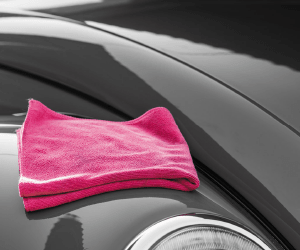
Time to Shine!
December 3, 2021
4 minute ReadBY BRENT MCCURDY
Brent McCurdy, former President of DuBois Auto Care and Blendco, provides a brief history of the clearcoat protectant category of online car wash offerings. From the initial waxes and protectants to the latest innovations and key ingredients, he offers insight on how far these products have come, what works best and what’s in store for the future.
 Car wash waxes have seen an amazing history over the last 25 years. Originally most online waxes were simply oils blended into a formulation that repelled water for a few days or a week. These oils were commonly referred to as mineral seal oils and at that time folks were happy to see some beading on their car window and hood in what the industry called cheater waxes. They aided in drying and were generically called waxes. A few hot days later or a brief rain shower and they were rinsed away.
Car wash waxes have seen an amazing history over the last 25 years. Originally most online waxes were simply oils blended into a formulation that repelled water for a few days or a week. These oils were commonly referred to as mineral seal oils and at that time folks were happy to see some beading on their car window and hood in what the industry called cheater waxes. They aided in drying and were generically called waxes. A few hot days later or a brief rain shower and they were rinsed away.
In the mid-1990s some companies like JBH Industries (the precursor to Blendco) in Texas offered products that were built with real waxes or polymer wax compounds. One product was called Red Rhino Wax. These products were both hyper concentrated AND had durability not achieved by the common cheater waxes and quickly grew in popularity as the lasting effects of a durable wax were appreciated and recognized by consumers.
In 1997 you had Hot Wax Inc. (a purveyor of a warm real wax protectant) actually involved in lawsuits with several car wash chemical vendors, Turtle Wax and Warsaw to name a couple, arguing their products did not actually contain “wax.” Our industry was aghast and annoyed since most operators were not actually under the impression these waxes were built off wax.
The fear of a lawsuit gave birth to a new name to this class of offerings and led to the common name of clearcoat protectants. This helped chemical companies and operators avoid lawsuits and most companies dropped the term wax. Even most industry experts would agree that the term wax had long become a reference to something that created a wax-like effect – the beading of water.
Clearcoat protectants were quickly expanded to include foaming products and products with color and scent, and were improved over the next decade to be more sophisticated. Sometimes this meant longer durability, and sometimes it meant improved drying performance as the drying agent category became much more important.
In 2011 the concept of hot wax was launched initially by Simoniz and quickly followed by the entire industry, and this time the name hot wax did not imply a hot temperature wax but instead a hot wax look as the foam included the addition of lighting to give the wax a hot lava look.
Carnauba was a common ingredient used in these hot wax formulations and while carnauba has been world renowned as a wax for many years, this time carnauba had helper ingredients that were the key to the softness and shine it delivered. While the marketing behind this new approach was undeniably attractive, what was less well known were the advances made in the chemistry to create this soft, smooth effect on the vehicle.
The problem was that the cost to get this highly smooth vehicle was near $1.00 per car. Operators sadly began to substitute real hot wax formulations for foaming products or reduced levels of the hot wax formulation. An offshoot of the foaming wax arch is that they gave birth to foaming all sorts of other products and adding light; many entrance arches now foam and use light on presoaks of all kinds.
Most recently, advances in chemistry have led to polymeric silicones that bond stronger with the vehicle and create a class of protectants now referred to as ceramics. The term “ceramic” is derived from the use of the polymeric silicones used today, which are silica-based polymers – silica being a major component of ceramics.
The term ceramic protectant has been used at detailers for 5-10 years and applications can cost as much as $2,000. This high-end treatment was generally only applied on SuperCars. These products are advertised as having 2-7 year durability.
The notion of marketing ceramic protectants at a wash both seemed alluring from a marketing perspective and from a durability perspective since the latest ceramic products leveraged advances in protection chemistry that far excelled even the most modern online protectants. The ceramic marketing has now expanded to total body protectants, clearcoat protectants, foaming protectants and even some drying agents.
The better of the ceramic protectants are more than just a name for marketing buzz – the best of these leverage all of the technology that history has led us to over the past 25 years and they contain ingredients that leave a soft hand waxed finish. But like the hot wax market before it, with time no doubt we will see ceramic products offered in name only, with little to no benefit over the clearcoat protectant technologies available today.
What is next? Diamond coatings? Titanium-coatings that are durable? I guess we wait and see, but if history is any indication, we have a lot more in store for advances in wax/clearcoat protectant/drying agent chemistries as the future unfolds!








